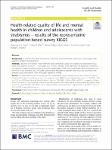Health-related quality of life and mental health in children and adolescents with strabismus – results of the representative population-based survey KiGGS
Schuster, Alexander K.
Elflein, Heike M.
Pokora, Roman
Schlaud, Martin
Baumgarten, Franz
Urschitz, Michael S.
Background
To estimate the effect of strabismus (squinting) on mental health and health-related quality of life aspects in children and adolescents.
Methods
Data from the German Health Interview and Examination Survey for Children and Adolescents KiGGS (2003–2006 baseline survey; N = 14,835, aged 3 to 17 years, 49% girls) were examined. The presence of strabismus was derived by parental questionnaire, and health-related quality of life and mental health were investigated with the KINDL-R and Strengths and Difficulties Questionnaire. Associations between strabismus and outcomes were analyzed using multivariable linear and logistic regression models.
Results
Of 12,989 children without missing data, 579 children (4.5% of the sample) were reported to have strabismus. Children with strabismus had lower scores in the parent-reported KINDL-R total scale (adjusted beta = − 1.02; 95%CI: -1.86 to − 0.18; p = 0.018) and sub-scale ‘friends’ (adjusted beta = − 2.18; 95%CI: -3.56 to -0.80; p = 0.002) compared to children without strabismus. The presence of strabismus was also associated with more mental health problems like ‘hyperactivity/inattention’ (adjusted OR = 1.50; 95%CI: 1.14 to 1.98; p = 0.005), and ‘peer problems’ (adjusted OR = 1.35; 95%-CI: 1.05 to 1.74; p = 0.018) as reported by parents.
Conclusions
Strabismus in children and adolescents is associated with lower health-related quality of life.

